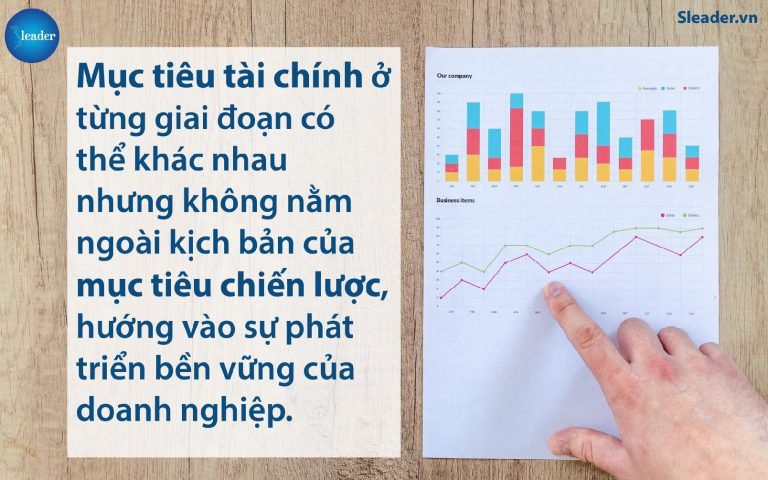
Strategic Goals and Financial Goals
Darwin once said that “the last survivors are not the most powerful or the smartest, but the most adaptable to change.” In the context of the Vietnamese economy and the world being seriously affected by the Covid-19 pandemic, businesses must also find ways to change and adapt to the drastic changes in the business environment. One of the preferred solutions first is to adjust financial planning to overcome unpredictable difficulties, but not to lose confidence in a chosen strategy before the epidemic. out.

There are two important types of goals that managers must always pay special attention to, namely profit performance (financial goals) and strategic performance (strategic objectives). While the strategic goal is the result of the concretization of the mission and vision, the financial objective serves the realization of the strategic goal. Financial goals at each stage may be different but not out of the scenario of strategic goals, aimed at the sustainable development of the business. For example, Vinamilk Dairy Company has defined a long-term strategic goal of achieving sales to become one of the 50 largest dairy companies in the world. However, from time to time, the Company sets different financial goals, such as reaching 3 billion USD in sales from 2012-2017 and 9 billion USD in 2018-2023.

Strategic goals and financial goals are closely related, with financial goals being an important part of strategic goals. Achieving financial goals is a must for every Company if it wants to stay in business. This was seen more clearly during the recession, when revenue and cash always fell faster than costs. Compared with the Dotcom 2001 bubble or the 2007-2008 global recession, this Covid-19 crisis is more dangerous when it both reduces supply and demand, causing the economy to freeze and hibernate. Given this difficulty, business organizations need to make quick and decisive adjustments to change their circumstances.
More specifically, businesses that are negatively affected by the Covid epidemic need to reconsider their resources, especially their financial resources. Cash flow assessment is one of the important contents to be done by answering the questions: Can the business withstand a few quarters of decline when the economy does not grow? How will businesses implement a contingency plan? Where can it be cut without causing fundamental damage to the business?
In addition, sales forecasting should be done scientifically based on changing customers\’ spending habits. Thus, in any circumstances, finance is always a measure of the health as well as the resilience of a business in the face of all changes.
For example, Mobile World Company has set out two missions related to financial goals to be able to stay in the market. Firstly, to focus on managing the available cash flow for business, ensuring to maintain stable operations, not expanding the task of increasing capital resources because the ability to raise capital at this stage is not feasible. Second, adjust the cost structure after the capital analysis, helping businesses have more cash flow to maintain business operations. The company has assigned personnel to cut costs, negotiate with landlords to reduce prices, and look for a cheaper location, sublease a part of the public building. companies and turn stores into freight storage.

Financial goals can be short-term or long-term depending on subjective factors (corporate development strategic goals) and objective factors (business environment, policies of the State, partners, and customers). row). On the objective factor, although the Government has set a common goal for sustainable development to 2030, it is consistently shown and spread across all fields: Economy (GDP, GNP) , Politics (peaceful, friendly environment), Social (education, culture, history).
However, when there was an objective negative impact from the Covid-19 epidemic, the Government, ministries and agencies soon adapted and resolved the challenges through a series of issued financial policies such as : Resolution 42 / NQ-CP on measures to support people in difficulty; Decree 41/2020 / NDCP extending tax payment for enterprises; Circular 01/2020 / TT-NHNN aims to restructure debt repayment period and exempt or reduce interest rates for businesses. From a subjective perspective, businesses that play a key role in the economy have also taken the lead in changing financial goals as well as sharing difficulties with customers. For example, Vietnam Electricity (EVN) has reduced electricity prices, encouraging online transactions; Commercial banks reduced lending interest rates, reduced payment service fees; Vietnam National Airlines (VNA) and Vietnam Tourism Association (VITA) jointly agreed to reduce aircraft prices by 50%, build tours on the basis of cost reduction, increasing benefits for customers .

At the present time, it can be seen that the Covid-19 epidemic has greatly affected the socio-economic life in general and enterprises in particular. Most businesses must adjust their financial goals to survive and adapt to the immediate situation but do not give up their long-term strategic goals. For example, in order to achieve short-term financial goals, some enterprises in Vietnam\’s textile and garment industry have made flexible changes to the export of apparel to serve domestic and export needs, instead of manufacturing. fashion items as before; Vinfast car factory under Vingroup has focused on manufacturing ventilators. However, in the long run, these businesses still have to return to their core industries to continue asserting their strengths recognized by the market.
There is a question always asked by managers, which is the strategic goal or the financial goal to prioritize? There is no answer for all businesses and under all circumstances, because startups are different from already branded businesses in the market, small and medium enterprises are different from large businesses that operate in the market. The active market period is different from those that operate when the market is quiet.
In short, one thing can be confirmed for sure, that the right strategic goal is the one for the best financial results, because once the business achieves return on investment (ROI). Being high is showing a competitive advantage or in other words achieving strategic goals.
Source: Institute of Strategic Leadership (SLEADER)



